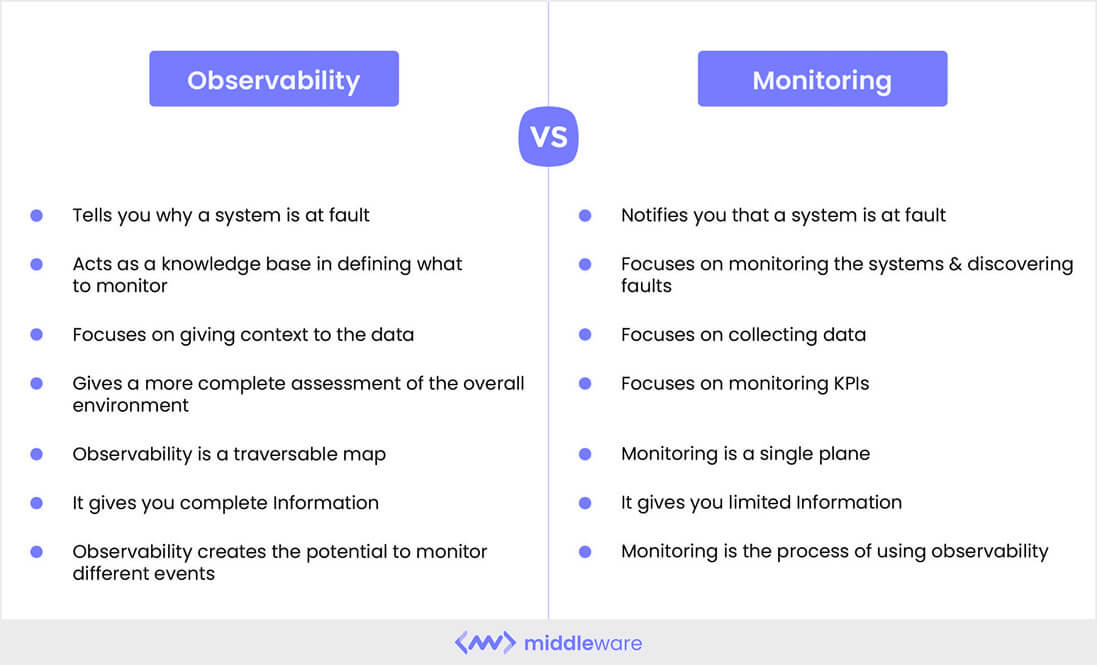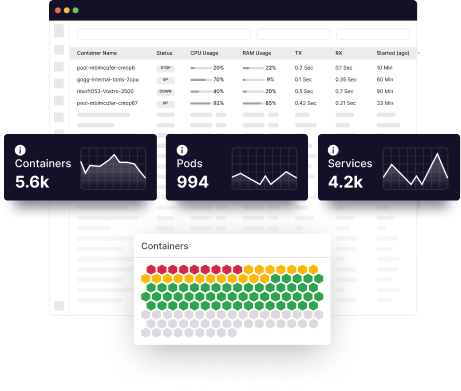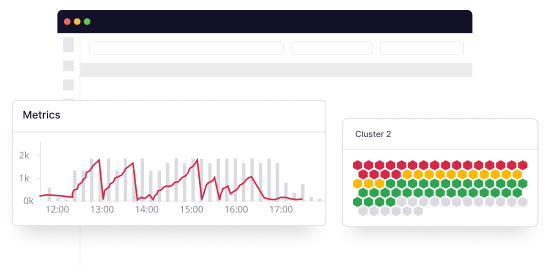Observability and monitoring are related concepts that are often used in the context of system administration, DevOps, and software engineering. While they are related, Observability vs. Monitoring are two distinct terms. In order to understand the importance of each and how they can be used in tandem, let’s take a look at what those terms mean.
Observability refers to the ability to understand the internal state of a system by examining its output. This includes the ability to gather data about the system, such as logs, metrics, and traces, and use this data to understand how the system is behaving.
Monitoring, on the other hand, refers to the practice of actively collecting data about a system and using it to detect issues. This can include setting up alerts to notify when certain thresholds are crossed, or using tools to analyze log data in real-time to detect issues.

In general, observability is a broader concept that includes monitoring, but monitoring is a specific practice that is a part of achieving observability. This article explains the key differences between Observability and Monitoring and how they can be used together for the best outcome.
What is observability?
Observability is the ability to measure a system’s current state based on the data it generates, such as logs, metrics, and traces. It helps thoroughly understand a system by examining the inputs.
An observability platform enables IT operations teams to simultaneously monitor—or gain a deeper understanding of—the status and health of various apps and resources within your IT infrastructure.
IT staff can proactively identify anomalies, examine issues, and find solutions by drawing insights from each system’s data. It provides insights into the underlying causes of those issues.
As cloud-native systems have grown more complicated and it has become harder to identify the potential root causes of a failure or anomaly, it has become more crucial in recent years. DevOps teams understand the benefits of observability data for the business and IT as they accumulate and use it.
The relationships between systems in your company’s multi-layered IT infrastructure, including cloud environments, on-premises software, and third-party apps, are understood using observability tools, which employ algorithms based on the mathematical control theory.
These tools then use logs, metrics, and traces—the so-called “three pillars of observability“—to monitor the condition and status of your systems. When the tool notices an anomaly, it alerts the team and gives them the information they require to troubleshoot and resolve the problem rapidly.
What is monitoring?
Monitoring is a procedure used to systematically gather, examine, and analyze data to actively monitor performance, maximize beneficial effects, and reduce the risk of harmful effects of a system, process, or device over a period of time.
It is a crucial component of efficient management because it can offer early and continuous information to help shape implementation before evaluations.
As opposed to a single discrete evaluation event or even numerous linked discrete evaluation events, monitoring incorporates evaluative thought into the periodic collection, analysis, and use of information during implementation (such as a mid-term and final evaluation).
This line has been blurred by more recent types of evaluation, like developmental evaluation and real-time evaluation, which involve ongoing data collecting, analysis, and use.
Monitoring systems frequently need to be incorporated into an organization’s ongoing internal processes. Monitoring may become a more challenging managerial task than evaluation due to the integration.
Observability vs Monitoring: What’s the actual difference?
Keeping track of systems is necessary for DevOps teams if they want to discern the state of their applications. This involves collecting and displaying data from multiple IT sources, which lets them know when something is awry. But it’s hard to get to the bottom of it without the aid of observability.
Observability and monitoring together give a complete view of the IT infrastructure. Monitoring acts as an early warning system, and observability helps pinpoint the origin of the problem and determine how to fix it. Monitoring an endpoint’s performance is essential even when it cannot be observed directly since it provides additional data that can be used to identify and address any issues with the system.

For development teams, the line between observability and monitoring is frequently hazy. So, let’s discuss observability vs. monitoring and their interrelationship.
Collection vs. Context
Monitoring notifies you if there is a fault in the system using a predetermined set of metrics and logs. You can identify a predetermined set of failure modes by monitoring applications. Monitoring technologies like application performance monitoring (APM) can inform you whether a system is online or offline or whether there is an issue with the performance of an application.
Observability tells you what the problem with a system is and how it was caused. It combines the information and data that monitoring generates to give you a comprehensive understanding of your system, including its performance and health.
Observability tells you why a system is at fault, and Monitoring notifies you that a system is at fault.
Tracking vs. Knowledge
Monitoring is the process of tracking a system’s performance over time. Metrics are used by monitoring systems to notify IT teams of operational issues with applications and cloud services. The main use of monitoring is to alert teams if there are any issues with the system.
The degree to which the system’s internal states may be deduced from knowledge of its external outputs is measured by its observability. It combines the information and data that monitoring generates to give you a comprehensive understanding of your system, including its performance and health.
Therefore, the degree to which your monitoring measures can decipher your system’s performance indicators will influence its observability.
Observability acts as a knowledge base in defining what to monitor, and Monitoring focuses on monitoring the systems and discovering faults.
Data Collection vs. Data Interpretation
In order to gain complete visibility, a complex environment must allow you to interpret its interior state from the data you gather about its surface. This involves, for instance, figuring out that a downed server or memory exhaustion is to blame for your application’s poor response time.
Observability is driven by surface-level data, which can take many different shapes. They include data from complementary systems, such as CI/CD pipelines or help desks, which provide crucial context for data, as well as logs, traces, and metrics from the software and infrastructure used in the environment where applications are run.
Monitoring provides data on a program’s usage trends and performance. One objective of monitoring is to achieve high availability by reducing important time-based KPIs. Application and service monitoring depend on features like real-time streaming, historical replay, and visualizations.
A well-monitored, Observability driven deployment provides data about its performance and health, enabling the team to identify production incidents quickly.
Observability focuses on giving context to the data, and Monitoring focuses on collecting data.
Key criteria vs. Complete assessment
With Observability, cross-functional teams can better comprehend and respond to precise queries about what’s happening in highly distributed systems. You can identify what is slow or broken and what needs to be done to improve performance. Teams can receive alerts about issues and proactively fix them before they impact users when they have an observability solution in place.
Unlike Observability, in a Monitoring scenario, you keep track of important KPIs that are intended to warn you of performance concerns you anticipate seeing later. Monitoring keeps track of all the KPIs, and you can see if there is any difference between real-time data and a predetermined value.
Observability gives a more complete assessment of the overall environment, while Monitoring focuses on KPIs.
Limited vs. Sustainable
Observability can be used to produce a better product as a sustainable alternative to monitoring operational insights, improved incident management, and quality control. It aids in securing practical insights for quicker feedback loops and better decision-making.
In the context of observability v/s monitoring, Monitoring is limited, while Observability is sustainable.
Single plane vs. Traversable map
In monitoring, you focus on setting up key rules and KPIs that need to be tracked. This makes monitoring a single plane as it can only alert you if there is an issue, you cannot map out the origin of the problem. The key assumption in setting up monitoring is that you’re able to predict what kinds of problems you’ll encounter before they occur.
On the other hand, Observability shows you the problem and lets you understand why there is an error or issue. It lets you traverse the different scenarios and reach the case of the problem, making it easier for teams to understand and troubleshoot.
Monitoring methods are single plane, while observability is a Traversable map.
Process vs. Potential
While the term “monitoring” is occasionally used to refer to anything distinct from observability, monitoring is a process that, combined with tracing and logging, makes a system observable as the “three pillars of observability,” monitoring, tracing, and logging are frequently referred to.
Understanding when anything goes wrong within the application delivery chain is crucial so you can find the underlying problem and fix it before it affects your business.
Monitoring and observability provide a two-pronged strategy. Monitoring provides situational awareness, and observability aids in determining what is happening and what should be done about it.
Observability creates the potential to monitor different events. Monitoring is the process of using observability.
What are the similarities between observability and monitoring?
DevOps teams appear to concur that monitoring and observability are separate operational kinds that solve different issues. Observability and monitoring go hand in hand. Monitoring tools can alert you when something goes wrong, and observability tools can support your investigation if you notice a problem.
Because not all issues found by monitoring technologies call for in-depth analysis, pairing monitoring and observability are advantageous. For example, your monitoring software may warn you that a server has gone offline despite being part of a planned shutdown. In that situation, you don’t need to gather and analyze various data to comprehend what transpired. Simply log the alert and carry on.
However, observability data is essential for quickly troubleshooting major issues. Although you could theoretically gather the same data that observability solutions automatically offer manually, doing so would add time to the incident response process.
Observability tools always guarantee the availability of the data you need to understand a difficult situation. Many systems also provide suggestions or automated analyses that can speed up the process by which teams sort through extensive observability data and locate core causes of issues.
We hope you enjoyed reading this detailed article about the key differences between Observability and Monitoring, which would have helped you draw the line between observability and monitoring.
FAQs about Observability vs. Monitoring
Is Observability part of DevOps?
Yes, Observability is a key part of DevOps. Observability in DevOps refers to the software tools and processes that assist Dev and Ops teams in logging, collecting, correlating, and analyzing vast amounts of performance data from a distributed application to gain real-time insights.
Is monitoring a subset of observability?
SRE teams use monitoring to check the overall health of individual servers, networks, and data storage in today’s DevOps environment. Monitoring is a subset of an environment’s overall observability goals.
What does observability mean in IT?
Observability is the ability to measure a system’s current state based on data it generates, such as logs, metrics, and traces, in IT and cloud computing. Observability is based on telemetry derived from instrumentation from your multi-cloud computing environments’ endpoints and services.
What is monitoring in DevOps?
DevOps monitoring entails overseeing the entire development process, beginning with planning and ending with deployment and operations. It involves obtaining a comprehensive and real-time picture of the status of applications, services, and infrastructure in the production environment.





